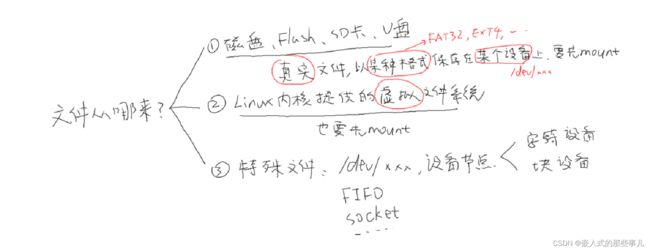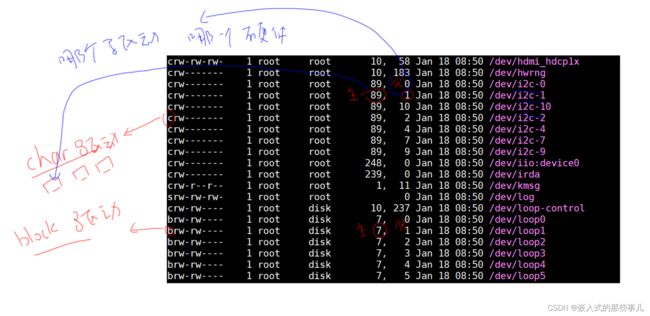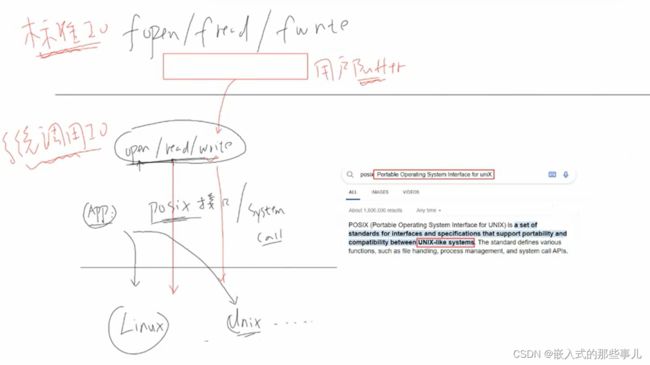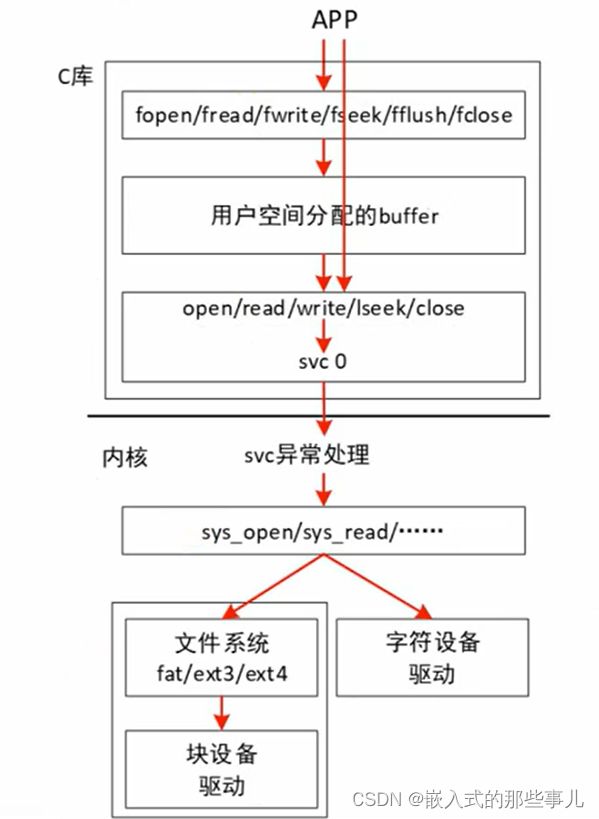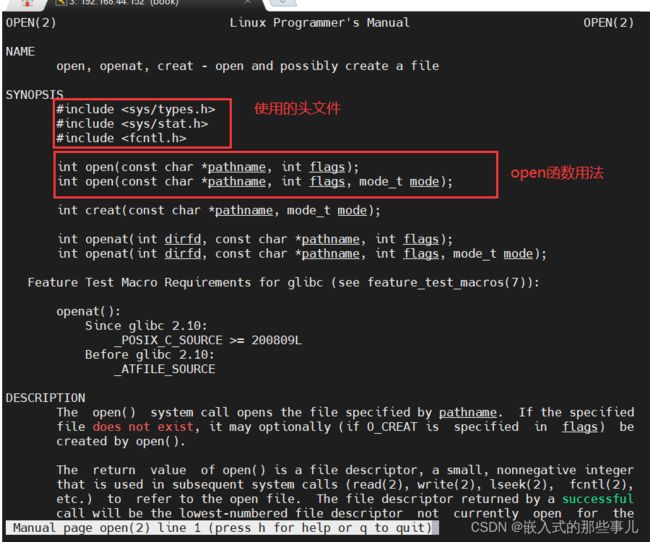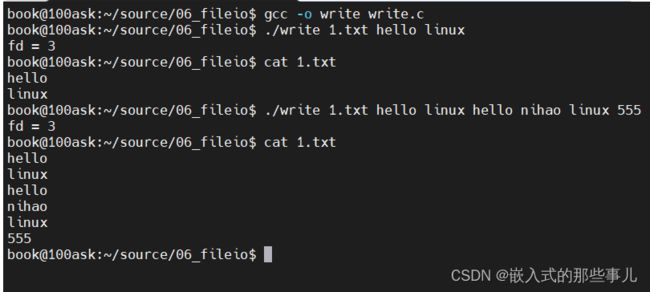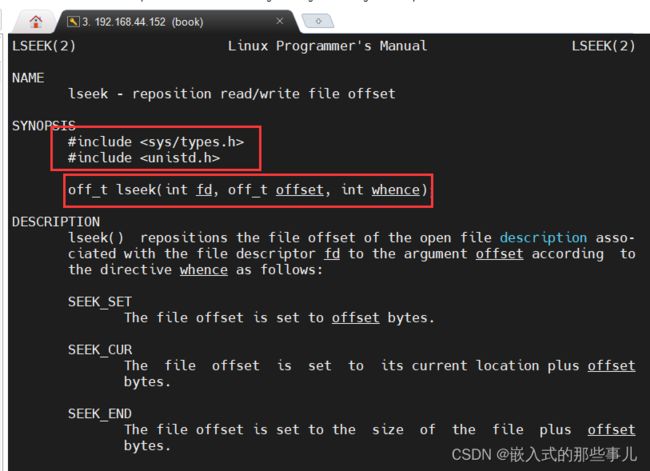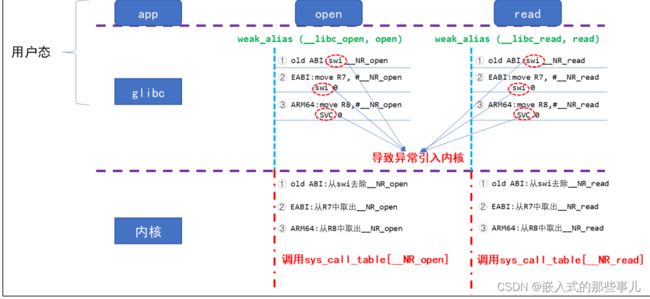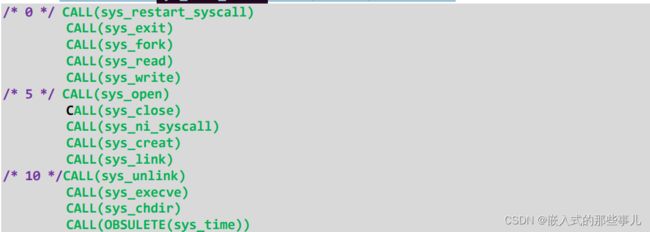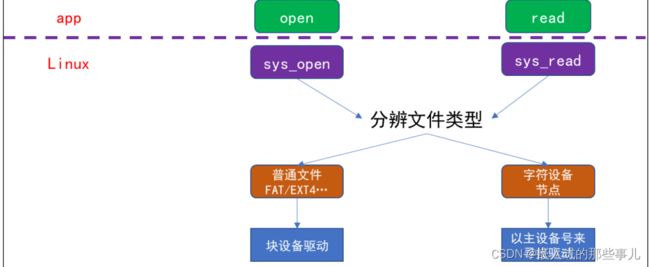Linux应用开发基础知识——文件IO操作(三)
前言:
在 Linux 系统中,一切都是“文件”:普通文件、驱动程序、网络通信等等。 所有的操作,都是通过“文件 IO”来操作的。所以,很有必要掌握文件操作的常用接口。
目录
一、文件IO
1.什么是文件:
2.怎么知道这些函数的用法?
3.文件IO的分类
二、使用open函数打开文件
1.用man命令进行查看文件使用方法
2.open.c 源码如下:
三、使用open函数创建文件
create.c 源码如下:
四、使用write函数写文件
1.用man命令进行查看文件使用方法
2 .write.c 源码如下:
五、lseek中间插入
1.用man命令进行查看文件使用方法
2 .write_in_poc.c 源码如下:
编辑 六、读写文件
1.通用的 IO 模型:open/read/write/lseek/close
2.不是通用的函数:ioctl/mmap
七、内核接口
1.系统调用函数怎么进入内核?
2.内核的 sys_open、sys_read 会做什么?
这 2 本书的内容类似,第一本对知识点有更细致的描述,适合初学者;第二 本比较直接,一上来就是各种函数的介绍,适合当作字典,不懂时就去翻看一下。 做纯 Linux 应用的入门,看这 2 本书就可以了,我们的侧重于“嵌入式 Linux”。
一、文件IO
1.什么是文件:
Linux 的文件既可以是真实保存到存储介质的文件也可以 是自身内核提供的虚拟文件,还可以是设备节点。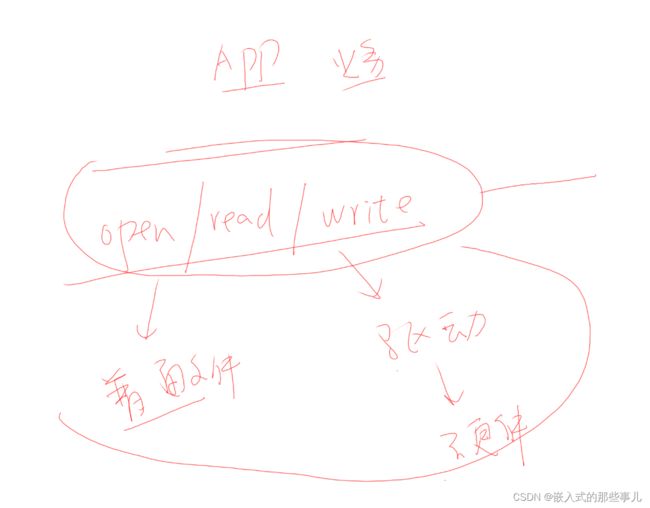
2.怎么知道这些函数的用法?
Linux 下有 3 大帮助方法:help、man、info。
想查看某个命令的用法时,比如查看 ls 命令的用法,可以执行:
ls --helphelp 只能用于查看某个命令的用法,而 man 手册既可以查看命令的用法,还可以查看函数的详细介绍等等。它含有 9 大分类,如下:
1 Executable programs or shell commands // 命令
2 System calls (functions provided by the kernel) // 系统调用,比如 man 2 open
3 Library calls (functions within program libraries) // 函数库调用
4 Special files (usually found in /dev) // 特殊文件, 比如 man 4 tty
5 File formats and conventions eg /etc/passwd // 文件格式和约定, 比如 man 5 passwd
6 Games // 游戏
7 Miscellaneous (including macro packages and conventions), e.g. man(7), groff(7) //杂项
8 System administration commands (usually only for root) // 系统管理命令
9 Kernel routines [Non standard] // 内核例程比如想查看 open 函数的用法时,可以直接执行“man open”,发现这不是 想要内容时再执行“man 2 open”。
在 man 命令中可以及时按“h”查看帮助信息了解快捷键。常用的快捷键是:
f 往前翻一页
b 往后翻一页
/patten 往前搜
?patten 往后搜
就内容来说,info 手册比 man 手册编写得要更全面,但 man 手册使用起来 更容易些。
以书来形容 info 手册和 man 手册的话,info 手册相当于一章,里面含有若干节,阅读时你需要掌握如果从这一节跳到下一节;而 man 手册只相当于一节, 阅读起来当然更容易。
3.文件IO的分类
标准IO: fopen/fread/fwrite/fseek/fflush/fclose
系统IO: open/read /write/lseek/close
这2种IO函数的区别:
二、使用open函数打开文件
1.用man命令进行查看文件使用方法
man 2 open
函数作用:
作用:打开或者创建一个文件
pathname: 文件路径名,或者文件名
flags:表示打开文件所采用的操作
O_RDONLY:只读模式
O_WRONLY:只写模式O_RDWR:可读可写
O_APPEND:表示追加,如果原来文件里面有内容,则这次写入会写在文件的最末尾。
O_REAT:表示如果指定文件不存在,则创建这个文件
O_EXCL:表示如果要创建的文件已存在,则出错,同时返回--1,并且修改·errno·的值。
O_TRUNC:表示截断,如果文件存在,并且以只写、读写方式打开,则将其长度截断为0。“
2.open.c 源码如下:
#include
#include
#include
#include
#include
#include
#include
/*
*./open_ 1.txt
*argc = 2
*argv[0] = "./open"
*argv[1] = "1.txt"
*/
int main(int argc, char **argv)
{
int fd;
if(argc != 2)
{
printf("Uage:%s \n",argv[0]);
return -1;
}
fd = open(argv[1],O_RDWR);
if (fd < 0)
{
printf("can not open file %s\n",argv[1]);
printf("errno = %d\n",errno);
printf("err: %s\n",strerror(errno));
perror("open");
}
else
{
printf("fd = %d\n",fd);
}
while(1)
{
sleep(10);
}
close(fd);
return 0;
}
三、使用open函数创建文件
设置创建文件并开启权限
fd = open(argv[1],O_RDWR | O_CREAT | O_TRUNC,0644);
create.c 源码如下:
#include
#include
#include
#include
#include
#include
#include
/*
*./create 1.txt
*argc = 2
*argv[0] = "./create"
*argv[1] = "1.txt"
*/
int main(int argc, char **argv)
{
int fd;
if(argc != 2)
{
printf("Uage:%s \n",argv[0]);
return -1;
}
fd = open(argv[1],O_RDWR | O_CREAT | O_TRUNC,0644);
if (fd < 0)
{
printf("can not open file %s\n",argv[1]);
printf("errno = %d\n",errno);
printf("err: %s\n",strerror(errno));
perror("open");
}
else
{
printf("fd = %d\n",fd);
}
while(1)
{
sleep(10);
}
close(fd);
return 0;
}
四、使用write函数写文件
1.用man命令进行查看文件使用方法
2 .write.c 源码如下:
#include
#include
#include
#include
#include
#include
#include
/*
*./write 1.txt str1 str2
*argc >= 3
*argv[0] = "./write"
*argv[1] = "1.txt"
*/
int main(int argc, char **argv)
{
int fd;
int i;
int len;
if(argc < 3)
{
printf("Uage:%s ...\n",argv[0]);
return -1;
}
fd = open(argv[1],O_RDWR | O_CREAT | O_TRUNC,0644);
if (fd < 0)
{
printf("can not open file %s\n",argv[1]);
printf("errno = %d\n",errno);
printf("err: %s\n",strerror(errno));
perror("open");
}
else
{
printf("fd = %d\n",fd);
}
for(i = 2; i < argc; i ++)
{
len = write(fd,argv[i],strlen(argv[i]));
if(len != strlen(argv[i]))
{
perror("write");
break;
}
write(fd,"\r\n",2);
}
close(fd);
return 0;
}
五、lseek中间插入
1.用man命令进行查看文件使用方法
2 .write_in_poc.c 源码如下:
#include
#include
#include
#include
#include
#include
#include
/*
*./write 1.txt str1 str2
*argc >= 3
*argv[0] = "./write"
*argv[1] = "1.txt"
*/
int main(int argc, char **argv)
{
int fd;
int i;
int len;
if(argc != 2)
{
printf("Uage:%s \n",argv[0]);
return -1;
}
fd = open(argv[1],O_RDWR | O_CREAT,0644);
if (fd < 0)
{
printf("can not open file %s\n",argv[1]);
printf("errno = %d\n",errno);
printf("err: %s\n",strerror(errno));
perror("open");
}
else
{
printf("fd = %d\n",fd);
}
printf("lseek to offset 3 from file head\n");
lseek(fd,3,SEEK_SET);
write(fd,"123",3);
close(fd);
return 0;
}
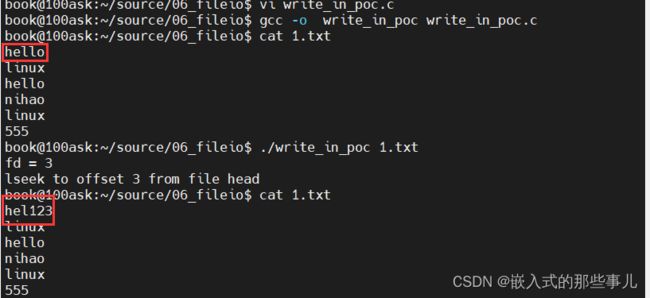 六、读写文件
六、读写文件
1.通用的 IO 模型:open/read/write/lseek/close
copy.c 源码如下:
#include
#include
#include
#include
#include
/*
* ./copy 1.txt 2.txt
* argc = 3
* argv[0] = "./copy"
* argv[1] = "1.txt"
* argv[2] = "2.txt"
*/
int main(int argc, char **argv)
{
int fd_old, fd_new;
char buf[1024];
int len;
/* 1. 判断参数 */
if (argc != 3)
{
printf("Usage: %s \n", argv[0]);
return -1;
}
/* 2. 打开老文件 */
fd_old = open(argv[1], O_RDONLY);
if (fd_old == -1)
{
printf("can not open file %s\n", argv[1]);
return -1;
}
/* 3. 创建新文件 */
fd_new = open(argv[2], O_WRONLY | O_CREAT | O_TRUNC, S_IRUSR | S_IWUSR | S_IRGRP | S_IWGRP | S_IROTH | S_IWOTH);
if (fd_new == -1)
{
printf("can not creat file %s\n", argv[2]);
return -1;
}
/* 4. 循环: 读老文件-写新文件 */
while ((len = read(fd_old, buf, 1024)) > 0)
{
if (write(fd_new, buf, len) != len)
{
printf("can not write %s\n", argv[2]);
return -1;
}
}
/* 5. 关闭文件 */
close(fd_old);
close(fd_new);
return 0;
}
book@100ask:~/source/06_fileio$ gcc -o copy copy.c
book@100ask:~/source/06_fileio$ ./copy copy.c new.c
2.不是通用的函数:ioctl/mmap
copy_mmap.c 源码如下:
#include
#include
#include
#include
#include
#include
/*
* ./copy 1.txt 2.txt
* argc = 3
* argv[0] = "./copy"
* argv[1] = "1.txt"
* argv[2] = "2.txt"
*/
int main(int argc, char **argv)
{
int fd_old, fd_new;
struct stat stat;
char *buf;
/* 1. 判断参数 */
if (argc != 3)
{
printf("Usage: %s \n", argv[0]);
return -1;
}
/* 2. 打开老文件 */
fd_old = open(argv[1], O_RDONLY);
if (fd_old == -1)
{
printf("can not open file %s\n", argv[1]);
return -1;
}
/* 3. 确定老文件的大小 */
if (fstat(fd_old, &stat) == -1)
{
printf("can not get stat of file %s\n", argv[1]);
return -1;
}
/* 4. 映射老文件 */
buf = mmap(NULL, stat.st_size, PROT_READ, MAP_SHARED, fd_old, 0);
if (buf == MAP_FAILED)
{
printf("can not mmap file %s\n", argv[1]);
return -1;
}
/* 5. 创建新文件 */
fd_new = open(argv[2], O_WRONLY | O_CREAT | O_TRUNC, S_IRUSR | S_IWUSR | S_IRGRP | S_IWGRP | S_IROTH | S_IWOTH);
if (fd_new == -1)
{
printf("can not creat file %s\n", argv[2]);
return -1;
}
/* 6. 写新文件 */
if (write(fd_new, buf, stat.st_size) != stat.st_size)
{
printf("can not write %s\n", argv[2]);
return -1;
}
/* 5. 关闭文件 */
close(fd_old);
close(fd_new);
return 0;
}
book@100ask:~/source/06_fileio$ gcc -o copy_mmap copy_mmap.c
book@100ask:~/source/06_fileio$ ./copy_mmap copy_mmap.c new2.c
七、内核接口
1.系统调用函数怎么进入内核?
以 open/read 为例,从用户态调用 API 触发异常进入内核的过程,最后调用的 sys_call_table 的函数指针数组如下:
2.内核的 sys_open、sys_read 会做什么?
进入内核后,sys_read/open 会首先根据参数判断文 件的类型,然后根据不同的文件类型去找不同的设备驱动,继而进行读写或者输 入输出控制。

